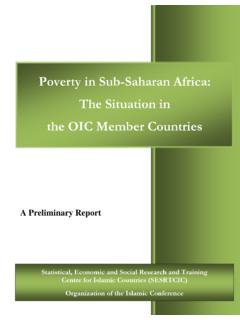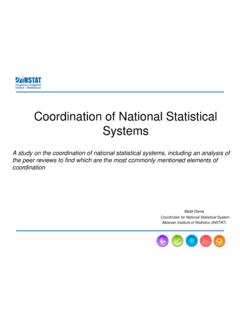Transcription of Exchange Rate Regimes in the OIC Member Countries
1 Exchange Rate Regimes in the OIC Member Countries OIC Outlook Series February 2012 ORGANISATION OF ISLAMIC COOPERATION STATISTICAL, ECONOMIC AND SOCIAL RESEARCH AND TRAINING CENTRE FOR ISLAMIC Countries SESRIC Attar Sokak No: 4, 06700 GOP, Ankara, Turkey Tel: +90-312-468 6172 (4 Lines) Fax: +90-312-467 3458 E-mail: Web: O R G A N I S A T I O N O F I S L A M I C C O O P E R A T I O N STATISTICAL, ECONOMIC AND SOCIAL RESEARCH AND TRAINING CENTRE FOR ISLAMIC Countries (SESRIC) OIC Outlook Series Exchange Rate Regimes in OIC Member Countries February 2012 1 OIC Outlook | Exchange Rate Regimes Introduction An Exchange rate can be defined as a price of one country s currency in terms of another currency.
2 Exchange rate regime refers to the system through which this price is determined and it is one of the most important policy instruments of governments. The choice of Exchange rate regime has considerable impact on trade in goods and services, capital flows, inflation, balance of payments and other macroeconomic variables. For this reason, the choice of an appropriate Exchange rate regime is a principal component of economic management in maintaining growth and stability. However, there is no consensus on how to select an appropriate Exchange rate regime and there is not an ideal Exchange rate regime suitable for all Countries . Specific country characteristics, policymakers preferences, credibility of institutions and policymakers can influence the choice of regime .
3 Most important factors influencing the decision are size and openness of the country to trade and financial flows, stage of economic and financial development, structure of trade and production, inflation records and the type of shocks the country faces. Once the decision is taken, a supportive policy environment, which includes prudent macroeconomic policies, consistent monetary policies and credible institutions, is needed for the Exchange rate regime to maintain a stable and competitive Exchange rate. In the presence of inconsistent policies and fiscal imbalances, crisis would be inevitable under any Exchange rate regime . Among others, Exchange rate Regimes have been considered as one of the factors in leading to crisis in emerging market economies.
4 Financial and currency crisis in Mexico (1994), Thailand, Korea and Indonesia (1997), Russia (1998), Brazil (1999), and Turkey and Argentina (2001) had severe negative impacts on economic growth. Although it is difficult to attribute any specific role to Exchange rate Contents Introduction Taxonomy of Exchange Rate Regimes Advantages and Disadvantages of Various Exchange Rate Regimes Policy Issues in Selecting Exchange Rate Regimes Exchange Rate Regimes in the OIC Member Countries A Common Currency and Monetary Policy for the Member Countries ? Concluding Remarks References 2 OIC Outlook | Exchange Rate Regimes Regimes in triggering the crises, the choice of the regime may significantly affect the course and depth of crises.
5 All above mentioned crises were forced by large capital outflows to abandon an Exchange rate target and to move to a more flexible Exchange rate regime . Some argued that setting explicit Exchange rate pegs was a mistake and other claimed that none of these crises would occur if they had been following explicit policies of tight Exchange rate pegs (Frankel, 2003). Given the importance of Exchange rate Regimes , this report provides a brief overview of the Exchange rate Regimes in the OIC Member Countries . After summarizing the types and advantages of the Exchange rate Regimes , policy issues in selecting Exchange rate Regimes will be discussed. Then the current Regimes adopted in the OIC Member Countries will be presented.
6 Before concluding, the discussions on the possibility of a single currency and monetary policy in the OIC region will be summarized. Taxonomy of Exchange Rate Regimes Exchange rate Regimes can roughly be classified into three categories: fixed (pegged), flexible (floating) and intermediate Regimes . Prior to 1970 s, most economies operated under fixed Exchange rate regime known as the Bretton-Woods system. Under this system, Countries fixed their Exchange rates against US dollar and the dollar was worth a fixed amount of gold. All participating currencies were implicitly pegged to the gold. The system was broken down after 25 years (1946-1971) but the system of fixed Exchange rate remained the preferred regime in many Countries .
7 The basic motivation for keeping Exchange rates fixed is the belief that a stable Exchange rate can facilitate trade and investment flows between Countries by reducing fluctuations in relative prices and by reducing uncertainty. Since 1971, economies have been moving towards flexible Exchange rate Regimes , where the value of the currency is determined by the market. In this setting, the domestic currency, all else equal, depreciates when demand for the foreign currency increases or supply of the foreign currency decreases and appreciates when demand for the foreign currency decreases or supply of the foreign currency increases. Although there are slight differences in the classification of the Exchange rates1, the one that is provided by Ghosh et al.
8 (2002) is preferred for the purpose of this outlook. As presented in Table 1, it involves 5 sub-categories and 10 different Exchange rate Regimes . 1 There are alternative classification systems in the literature. Another frequently used classification, preferred also by IMF, involves (ranked on the basis of the degree of flexibility): independent floating, managed floating, crawling bands, crawling pegs, pegged within bands, fixed peg arrangements, currency board arrangements and Exchange arrangements with no separate legal tender. 3 OIC Outlook | Exchange Rate Regimes Table 1: Classification of the Exchange Rate Regimes Classification Sub-classification regime Main Characteristics Pegged Regimes Hard Pegs Exchange rate is pegged in a manner that makes a change in parity or an exit from the regime extremely difficult and costly Dollarization A foreign currency is used as a legal tender, even though in some cases domestic coins are used.
9 Monetary policy is delegated to the anchor country. Seigniorage accrues to the issuing country. Currency Boards The Exchange rate is pegged to a foreign (anchor) currency, with the regime and the parity enshrined in law. The law would also specify a minimum amount of international reserves to be held by the central bank to back a certain percentage of a pre-specified monetary aggregate. Main difference from dollarization: seignorage accrues to the home country. Monetary Union A group of Countries uses a common currency issued by a common regional central bank. Monetary policy is determined at regional level; seignorage accrues to the region. No option to adjust par-values internally; externally, the monetary authority issuing the common currency can pursue any Exchange rate policy.
10 Traditional Pegs Currency is linked to a single foreign currency or to a basket of currencies. Cost of adjusting the parity or of abandoning the regime is lower than in the case of hard pegs Single Currency Peg The Exchange rate is pegged to a fixed par-value to a single foreign currency. The central bank is expected to trade at the announced par-value, but the rate is generally adjustable (through discrete devaluations or revaluations) in case of fundamental disequilibria. Credibility is greater the higher the level of central bank reserves, but generally reserves do not fully cover all domestic liabilities, leaving some room for discretionary monetary policy. Basket Peg Similar to single currency peg, except that the currency is pegged to a basket consisting of two or more currencies.






